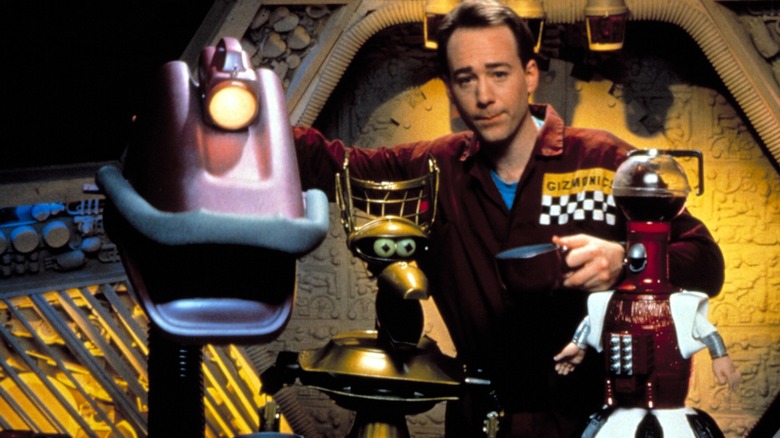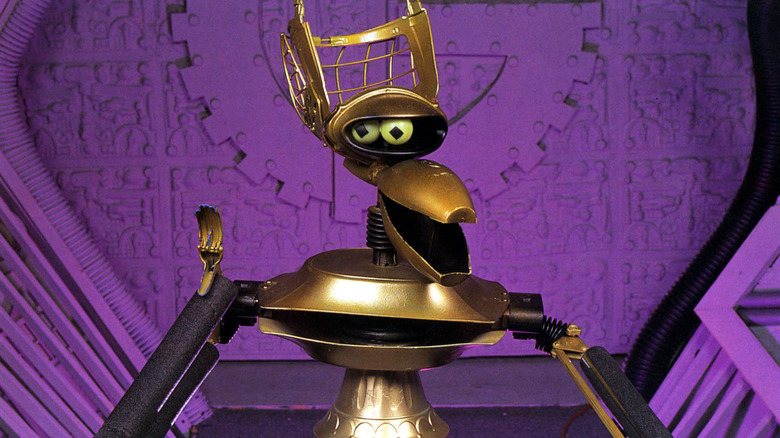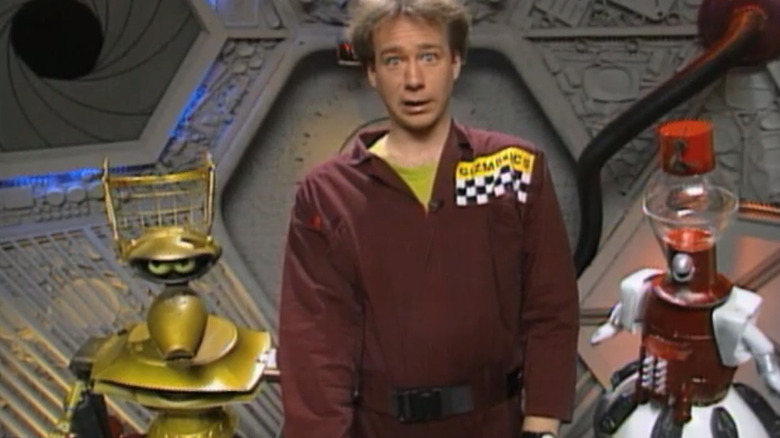The Mystery Science Theater 3000's Writers Room Wasn't As Wild As You Think
Back in 1988, when he was first conceiving "Mystery Science Theater 3000," show creator Joel Hodgson wanted it to serve as a late-night hangout. His local Minnesota TV station, KTMA, had a store of cheap genre films they would throw on late and night, and Hodgson wanted to recreate the phenomenon of staying up late with friends, watching these valueless, cheesy movies, and have a good time. As organically happens when large groups of friends stay up late to watch bad flicks on TV, jokes are going to be made at the movie's expense. Hodgson would gather in a theater with two friends, the robots Tom Servo and Crow T. Robot, and they would improvise throughout Gamera movies or Gerry Anderson's Supermarionation films. The early KTMA episodes of "MST3K" were laidback, and there were a lot of spans of silence as Joel and the 'bots watched the movies.
There was little pressure, because KTMA was such a small station. Trace Beaulieu, who played both Crow T. Robot and the evil mad scientist Dr. Clayton Forrester on the show said, "I think you had to have a round antenna on the back of your set to get it. It was really done as a lark."
When Hodgson and the rest of the showrunners began shopping the series to other, larger channels — hoping to be paid — they assembled a sizzle reel of all their best riffs and jokes. When Hodgson saw the completed reel for the first time, finally able to see jokes at a much higher volume, he realized that the show needed to be far more joke-dense. They couldn't just improvise anymore. They needed something tighter and scripted.
In a 2008 interview with The Seattle Times, Hodgson and Beaulieu described what it was like to start a proper writers' room on "MST3K," and how intense it was to up the joke factor.
Finally getting paid
When "MST3K" was finally picked up by The Comedy Channel (which later merged with Ha! to become Comedy Central where the show would remain for years), Hodgson and crew had to knuckle under. Luckily, in being paid, everyone could finally devote more time to joke writing:
"We had been improvising. When we started getting paid, that's when I decided we needed to write them. I wanted it to be much tighter, and we could afford to because now we could spend eight hours a day (on the scripts). Prior to that we did (a whole episode) in a day."
Luckily, everyone in the writers' room had an encyclopedic knowledge of film and of pop culture. No matter what genre the writers were viewing, they were able to write contextual riffs with the aplomb of a research scientist, bringing in references to "Blanskey's Beauties," the weekly NBC Mystery Movie, Ingmar Bergman, William Shakespeare, "T.H.E. Cat," and early R.E.M. lyrics. Unknown film stars drifted into their field of vision, and they re-drew their pop culture maps to match. Says Beaulieu:
"We covered a lot of genres. Westerns, teen exploitation movies. We did a biker movie. There was a spate of wannabe Elvis crooners in the late '50s. We did a couple of those, including 'Daddy-O' with Dick Contino."
Everyone must not get stoned
"MST3K" was, with its late-night broadcast time, homemade look, and loosey-goosey tone, a staple for drinkers and stoners. Indeed, the practice of consuming marijuana and watching a bad movie had long been accepted practice; the "midnight movie" phenomenon began in earnest in the 1970s when a New York theater owner, unsure how to exhibit the acid Western "El Topo," decided to show it after hours ... and to allow smoking in the theater. The association between weed and trash cinema has been solid ever since.
One might assume that the "MST3K" crew were also of a similar mindset during production. Surely the writers' room was well stocked with bongs and other marijuana accoutrements. The truth is far less intoxicated and far more professional. Hodgson was asked about that:
"People would say, 'Surely you write them when you were high.' No, we never did."
He did recall one time when there was tequila in the writers' room, along with a supply of Mickey's Big Mouth malt liquor (5.6% ABV). Hodgson pointed out that it didn't work for writing, and that everyone got headaches.
This author recalls attending a live show hosted by Richard O'Brien, the creator of "The Rocky Horror Picture Show," who told a story of how one cannot make a movie — however wild — when constantly high or drunk. At some point, he said, you have to actually do the work. And for that, it helps if you're sober. The crew on "MST3K" adhered to a similar philosophy, and had to remain completely professional in order to make the show seem as laid back as it was. Substances were not taken. It was not a party. It was more like a fact-finding excursion.
Write drunk, edit sober? No. Write sober, film sober, edit sober, and you might just create a cult phenomenon that lasts nearly 35 years. Then, once you get home (and you're over 21), have a martini.


